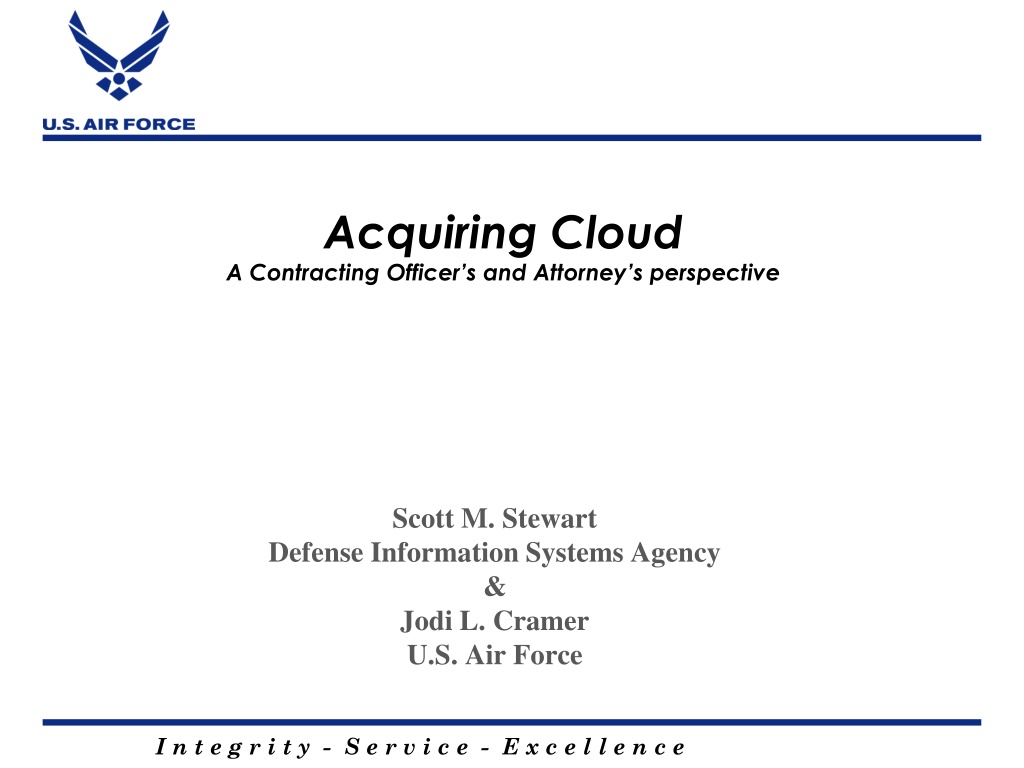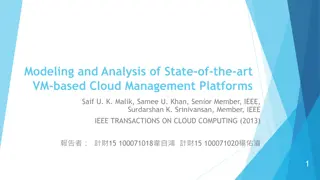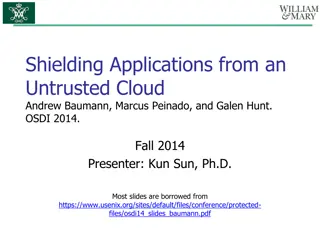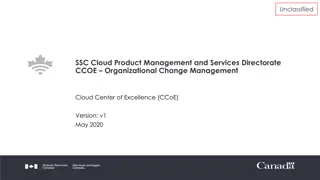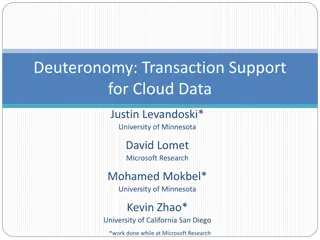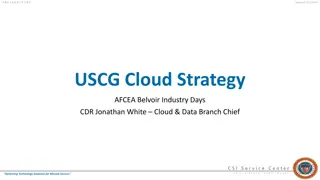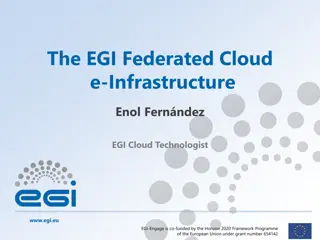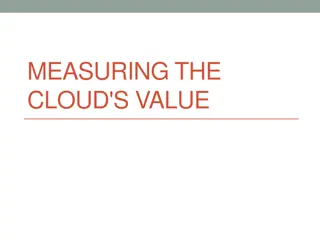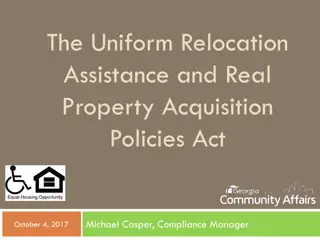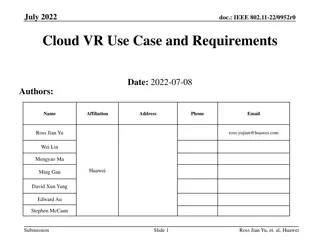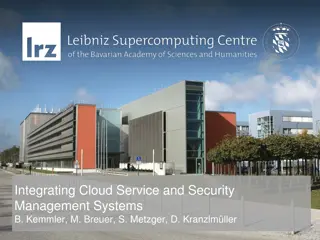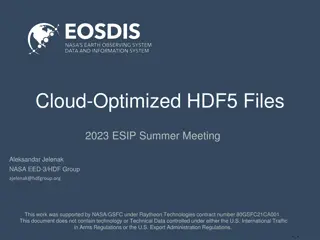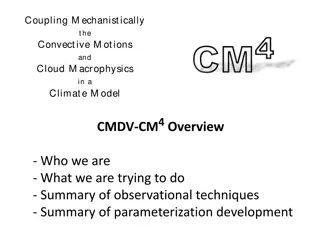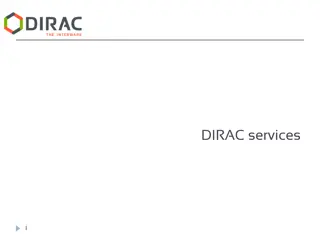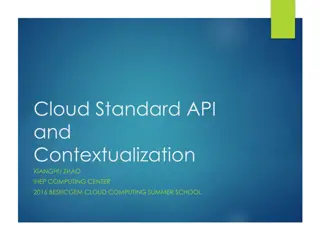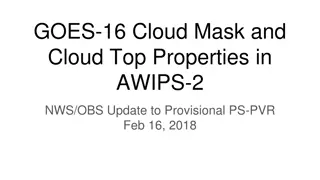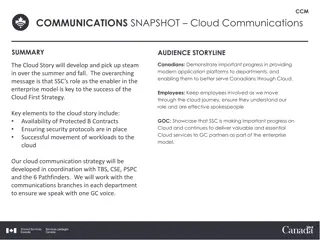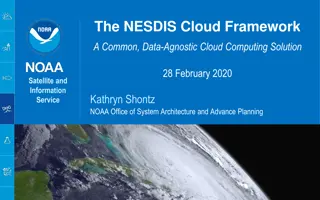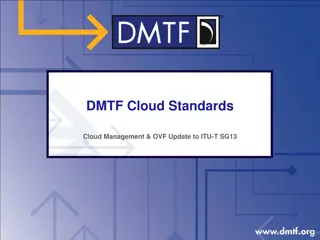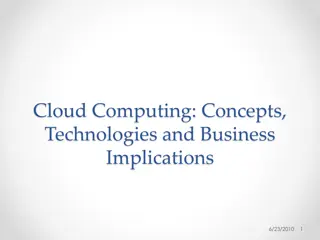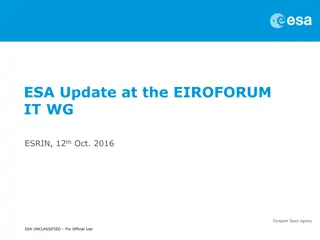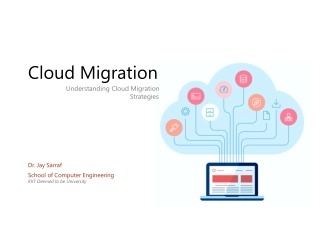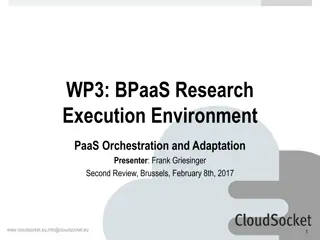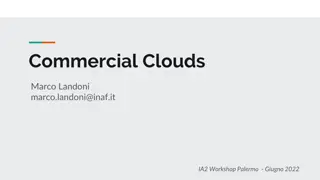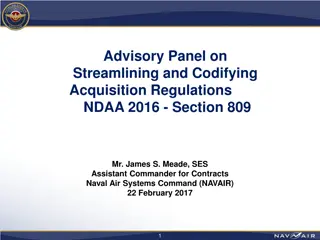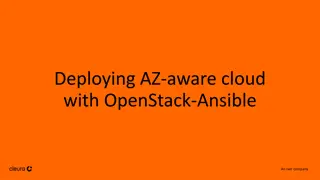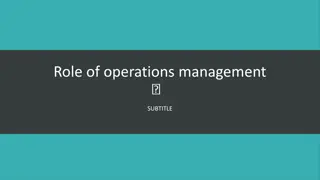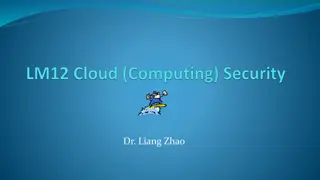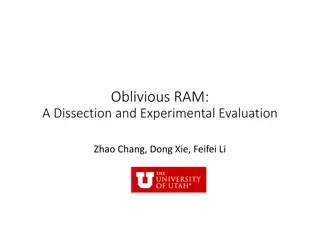Understanding Cloud Services Acquisition for Efficient Operations
Explore the perspectives of a contracting officer and attorney on acquiring cloud services efficiently. Uncover the benefits of cloud computing, service models, deployment options, and acquisition guidance for streamlined operations. Learn about different cloud service models and deployment options to optimize IT infrastructure and reduce costs.
Download Presentation

Please find below an Image/Link to download the presentation.
The content on the website is provided AS IS for your information and personal use only. It may not be sold, licensed, or shared on other websites without obtaining consent from the author. Download presentation by click this link. If you encounter any issues during the download, it is possible that the publisher has removed the file from their server.
E N D
Presentation Transcript
Acquiring Cloud A Contracting Officer s and Attorney s perspective Scott M. Stewart Defense Information Systems Agency & Jodi L. Cramer U.S. Air Force I n t e g r i t y - S e r v i c e - E x c e l l e n c e
Agenda The objective of this presentation is to help components efficiently and effectively acquire cloud services. Benefits of Cloud Computing Service Models Deployment Models Security and Impact Levels Acquisition Guidance and Regulations Process for Acquiring Cloud Services Summary Questions I n t e g r i t y - S e r v i c e - E x c e l l e n c e 2
What is Cloud? I n t e g r i t y - S e r v i c e - E x c e l l e n c e 3
Cloud computing supports DoD IT infrastructure improvement initiatives On-demand self-service insuring faster response to new requirements Sharing IT infrastructure reducing department costs Standardization in the delivery of services reducing the costs for operating IT infrastructure More consistently applying security controls improving IT security Measured service more accurately capturing IT usage and costs I n t e g r i t y - S e r v i c e - E x c e l l e n c e 4
There are three primary cloud service models: IaaS, PaaS, and SaaS Infrastructure as a Service Virtual Servers Storage Services Network Services Platform as a Service Application Development Servers Programming Support Developer Services Data Services Software as a Service Office Automation Enterprise Mission Applications Communications Services I n t e g r i t y - S e r v i c e - E x c e l l e n c e 5
There are also several options for deploying cloud services Private Cloud infrastructure is deployed solely for a single customer s requirements Public Cloud infrastructure is shared by diverse tenants at cloud service provider s facilities Community Cloud infrastructure is shared by similar types of tenants with similar requirements (e.g. the DoD Milcloud) Hybrid Cloud customer s IT infrastructure includes both Private Cloud and Public Cloud, more sensitive processing and data are kept on Private Cloud, less sensitive processing is performed on Public Cloud (Public Cloud can be used to handle non- sensitive surge) I n t e g r i t y - S e r v i c e - E x c e l l e n c e 6
Unclassified Unclassified DoD Commercial Cloud Deployment Approach DoD Commercial Cloud Deployment Approach *Vendors named within are approved or under contract to provide specified services to DISA or DOD* Cyber Command C2 Operations Off Premise Level 2 Approved Vendors On Premise Level 1-5 Cloud Providers Internet-based User Internet Internet Access Points Boundary Protection for Internet Traffic East/West Big Data Analytics Joint Regional Security Stacks Off Premise Level 4/5 Approved Vendors NIPR-based User Secure Cloud Computing Architecture (SCCA) Cloud Access Points Boundary Protection for Impact Level 4 & 5 Global Content Delivery System (Commercial Caching) Microsoft Azure For Government GovCloud Meet-Me Point Central Location for DoD and Cloud Connections Global Content Delivery System (Commercial Caching) Microsoft O365 For Government DISN JEDI DoD Controlled Environment Commercial Controlled Environment w/DoD Oversight I n t e g r i t y - S e r v i c e - E x c e l l e n c e
DoD Use Two types: Government system DoD Security and Contract Language Contractor/Grantee System Requirement is FedRamp Moderate I n t e g r i t y - S e r v i c e - E x c e l l e n c e
Government Information System Information system used or operated by an agency or by a contractor of an agency or by another organization on behalf of an agency. OMB Circular A-130 I n t e g r i t y - S e r v i c e - E x c e l l e n c e
DoD Documents DoD Cloud Security Requirements Guide http://iase.disa.mil/cloud_security/Page s/index.aspx DFAR 252.739-7010 https://www.federalregister.gov/docume nts/2015/08/26/2015-20870/defense- federal-acquisition-regulation- supplement-network-penetration- reporting-and-contracting-for I n t e g r i t y - S e r v i c e - E x c e l l e n c e
The CO should be familiar with several cloud services security initiatives FedRAMP - is a government-wide program that provides a standardized approach to security for cloud services. DOD leverages FedRAMP and other Federal Agency security documentation residing in the FedRAMP Secure Repository when it conducts security assessments. DoD adds security controls to FedRAMP to meet its additional security requirements, known as FedRAMP+ DoD Provisional Authorization is provided to non-DoD cloud service offerings that have properly implemented the FedRAMP controls and the additional controls and requirements of the DoD Cloud Computing Security Requirements Guide Cloud Access Point For Level 4 and above CSO, provides a barrier of protection between the DOD and DOD use of commercial cloud services. The CAP will proactively and reactively prevent attacks against the DODIN infrastructure and mission applications I n t e g r i t y - S e r v i c e - E x c e l l e n c e 12
The security Impact Level of the system to be deployed will affect procurement I n t e g r i t y - S e r v i c e - E x c e l l e n c e 13
Impact Level 2 Public facing data Public websites (example: www.defense.mil) Public data not on public facing websites Internal portals that link to other sites Early Bird Names of DoD employees at the O6/civilian equivalent and below not in public liaison positions are not public data per Long vs. OPM I n t e g r i t y - S e r v i c e - E x c e l l e n c e
What is Controlled Unclassified Information (CUI) Controlled Unclassified Information (CUI) is any information that is exempt from release under The Freedom of Information Act (FOIA). FOIA has 9 Exemptions: 2. Internal Personnel Matters 3. Other Statutes 1. Classified 5. Inter/Intra Agency Pre-decisional attorney work product 4. Commercial/ Trade secrets 6. Personal Privacy 8. Financial Institutions 9. Geological Information 7. Law Enforcement I n t e g r i t y - S e r v i c e - E x c e l l e n c e
Impact Level 4/5 Level 4 is: Level 5 is: All CUI not level 5. NSS Systems Any data protected by another law or regulation. I n t e g r i t y - S e r v i c e - E x c e l l e n c e 13 AUG 2013 -- 1630 16
Statutes Requiring Additional Protection Military Critical infrastructure 10 USC 130 (e) Civilian Critical infrastructure Critical Infrastructure Information Act of 2002 Deployment and troop movement 10 USC 130 (b) Unclassified nuclear data - 42 U.S.C. 2162 Trade Secrets Act data - 15 U.S.C. 46(f), 57b-2, 15 U.S.C. 3710a(c) Promotion materials Privacy Act Exceptions 5 USC 552a (k)(7) Testing materials Privacy Act Exceptions 5 USC 552a (k)(6) I n t e g r i t y - S e r v i c e - E x c e l l e n c e
Statutes Requiring Additional Protection cont. Sensitive PII (medical/HIPPA, personnel related to sexual assault DoDI 6495.02 especially for restricted reports The Crime Victim s Rights Act, 18 U.S.C, Section 3771 (implemented in the military through Article 6b, UCMJ 10 U.S.C., Section 806b) which states that victims have a right to be reasonably protected from the accused and the right to be treated with fairness and with respect for the victim s dignity and privacy. Biometric data/Security clearance information Privacy Act Exceptions 5 USC 552a (K)(5) Biometric data/Legal/law enforcement Privacy Act Exemptions 5 USC 552a (j)(2), (k)(1),(k)(2), (k)(3) * Only a preliminary list. There may be other statutes protecting data elements. I n t e g r i t y - S e r v i c e - E x c e l l e n c e
The CO should be familiar with relevant acquisition regulations and guidance DOD organizations are responsible for acquiring the cloud services that meet their mission objectives and provide an optimal solution compliant with DOD and other federal regulations Important cloud related guidance documents (more in backup slides) DoD CIO Memorandum: Updated Guidance on the Acquisition and Uses of Commercial Cloud Computing DoD Cloud Computing Security Requirements Guide FedRAMP Control Specific Contract Clauses DISA Cloud Connection Process Guide (CCPG) Defense Federal Acquisition Regulation Supplement (DFARS) Subpart 239.76 Cloud Computing I n t e g r i t y - S e r v i c e - E x c e l l e n c e 19
Key areas that the CO needs to address in the procurement of Cloud Services Availability and Availability Reporting of the Cloud Services A Business Case Analysis needs to be developed Protection of Government Data Include Indemnification Clauses in Contract Access to Government Data for Law Enforcement and Other Purposes Location of Government Data Government Records Management Policies Support of Government Security Regulations Defining SLAs Government Documentation of DoD Cloud Services Procured Subcontracting Rules Supply Chain Management Terms of Service I n t e g r i t y - S e r v i c e - E x c e l l e n c e 20
The CO shall define the availability and availability reporting requirements Service Interruption Reporting The Contractor must inform the Government of any interruption in the availability of the cloud service as required by the service level agreement. Outage Estimate Whenever there is an interruption in service, the Contractor shall inform the Government of the estimated time that the system or data will be unavailable. System Availability Requirements The estimated timeframe for recovery of the service must be related to the FIPS 199 system categorization for the availability of the system, and if specified, the Contractor shall meet the agreed upon service level and system availability requirements. The Contractor shall provide regular updates to the Government on the status of returning the service to an operating state according to the agreed upon SLAs and system availability requirements. I n t e g r i t y - S e r v i c e - E x c e l l e n c e 21
The organization shall prepare a Business Case Analysis (BCA) for Cloud Services A BCA is required by DoD CIO Memo, Updated Guidance on the Acquisition and Use of Commercial Cloud Computing Services, December 15, 2014 It provides an analysis of the cloud services requested using the DoD CIO IT Business Case Analysis (BCA) template Consider DISA provided cloud services as an alternative in the BCA Have the approval of the Component CIO Provide a copy of the BCA to the DoD CIO I n t e g r i t y - S e r v i c e - E x c e l l e n c e 22
The Contract Officer shall ensure protection for government data Protection of government data is required by the Federal Acquisition Regulations (FAR) procedures, guidance, and information (PGI) Data ownership, licensing, delivery and disposition instructions specific to the relevant types of Government data and Government-related data shall be part of the contract Appropriate limitations and requirements regarding contractor and third-party access to, and use and disclosure of, Government data and Government-related data shall be documented in the contract Appropriate requirements to support applicable inspection, audit, investigation, or other similar authorized activities specific to the relevant types of Government data and Government-related data, or specific to the type of cloud computing services being acquired Appropriate requirements to support and cooperate with applicable system-wide search and access capabilities for inspections, audits, investigations, litigation, eDiscovery, FOIA requests, records management associated with the agency s retention schedules, and similar authorized activities A requirement for the contractor to coordinate with the responsible Government official designated by the contracting officer, in accordance with agency procedures, to respond to any spillage occurring in connection with the cloud computing services being provided A requirement that the Contractor shall use Government-related data only to manage the operational environment that supports the Government data and for no other purpose unless otherwise permitted with the prior written approval of the Contracting Officer. I n t e g r i t y - S e r v i c e - E x c e l l e n c e 23
Commercial Cloud Commercial Cloud Considerations Considerations DFAR CLAUSE Physical Access OCI Data Breach Facility Inspection Law Enforcement Notification Records Management Spillage DoD Cloud SRG Personnel Access Jurisdiction SCRM I n t e g r i t y - S e r v i c e - E x c e l l e n c e
Commercial Cloud Commercial Cloud Considerations Continued Considerations Continued Additional DoD Identified NDA Asset Availability Banner Continuous Monitoring Compliance Direct Relationship Indemnification Cyber Insurance Maintenance TOS GAO Stakeholder Roles And Responsibilities Terms And Dates Measurable Performance Objectives Access To Agency Data Service Management Requirements Disaster Recovery Planning Exception Criteria Security Performance Requirements Notification of Security Breach Consequences I n t e g r i t y - S e r v i c e - E x c e l l e n c e 25
Contract Clauses and Considerations Industry feedback is negative for three of the DFARS candidates (RED) Security Privacy Law Enforcement Admin Org Conflict of Interest Operational Control (Direct Relationship) Non-Disclosure Physical Access Law Enforcement Access Record Management Spillage Data Breach Supply Chain Risk Management Insurance Facility Inspections Terms of Service Maintenance Location of Data Indemnification FISMA Compliance Notification Continuous Monitoring Banner Asset Availability Personnel Access I n t e g r i t y - S e r v i c e - E x c e l l e n c e 26
TERMS OF SERVICE CONFIDENTIALITY Issue: This is a clause where the government agrees not to release confidential information. However, the government is subject to the Freedom of Information Act and must follow its procedures to release or protect commercial information. Many commercial services have Terms of Service Agreements that contain clauses that the government cannot accept. INDEMNIFICATION Many terms of service agreement contain an open ended indemnification clause where the government will indemnify the CSP against third party claims. This type of clause violates the Anti-Deficiency Act because the government is committing to funds that have yet to be appropriated. This clause needs to be re- worked to reference other applicable laws. ALREADY a FAR CLAUSE GOVERNING LAW Many terms of service agreements have the governing law for the agreement to be a specific state and have a venue for any disputes to be in that state s courts. As the Federal government is not subject to state law, it can only be sued in Federal court. ENDORSEMENT Many terms of service agreements also have a clause where the CSP may quote / cite the government s use of its product as an endorsement or testimonial. The government does not endorse commercial products or services. I n t e g r i t y - S e r v i c e - E x c e l l e n c e
BANNER Issue: Banners or consent to monitor language allows Federal law enforcement the right to access and review government data including email created on a government system without a warrant or a subpoena. When a Government is only procuring hosting the banner will be a requirement of the government or contractor who developed the system, however, when the government procures software as a service, the Agency must require the CSP to display the Agency s approved banner language prior to allowing a user access to the system. All users of DoD systems have constructively consented through the banner language to monitoring of their use of a DoD system and use of that data for law enforcement purposes. As such, Federal law enforcement, investigative, and auditing officials do not need a warrant or a subpoena to access Government data on a Government system. I n t e g r i t y - S e r v i c e - E x c e l l e n c e
OPERATIONAL CONTOL Direct Relationship Definitions of Operational Configuration and Control: Issue: When subcontracting, the Agency should ensure the prime retains operational configuration and control of DoD data. This is particularly important in the event of a data breach. Configuration control means having the authority to approve or disapprove any and all changes to the hardware and software used in the data repository systems. Operational control means having the authority over the components of the data repository systems to include the hardware, software, processes and personnel used to process or store government data. I n t e g r i t y - S e r v i c e - E x c e l l e n c e
INSURANCE Issue: The Agency must require a CSP to have the necessary insurance to pay for any costs stemming from a breach of DoD data or to replace any damages to the DoD system. Program managers need to assist the KO in determining the amount of cyber insurance the CSP needs for the data. Note: Insurance amounts varies on type of data. I n t e g r i t y - S e r v i c e - E x c e l l e n c e
NDA Issue: The Agency must require CSP employees with access to government data and other government confidential information to sign a non-disclosure agreement that would legally prevent a CSP employee from disclosing non- public government information. As with background checks, Program managers need to determine which CSP employees need to sign NDAs. I n t e g r i t y - S e r v i c e - E x c e l l e n c e
SLAs are important in a cloud environment since the organization is giving up control over certain aspects of their IT services The CO procuring cloud services shall incorporate a SLA into the contract with the Contractor The SLA shall clearly define the contract performance standards, how the contractor will measure and report the service performance, and the enforcement mechanisms for SLA compliance. The CO shall also ensure that the contract clearly specifies whether there are any maintenance windows when service can be disrupted and notification procedures for planned and unplanned outages. The CO should also clearly define any monitoring and metering requirements the organization has for monitoring the performance of the CSP and capturing the organization s usage patterns and for charging the organization s clients for services. I n t e g r i t y - S e r v i c e - E x c e l l e n c e 32
The Component shall ensure they properly document their cloud service SNAP. The CSO needs to be documented in the Systems Network Approval Process (SNAP) database, so that DISA, on behalf of the DoD CIO can track all CSPs hosting DOD information and for the DoD Information Network (DoDIN) documentation and tracking purposes. It is a OSD/CAPE web tool on both SIPRNET & NIPRNET SNaP-IT. The Component shall report in the Select and Native Programming Data Input System for Information Technology (SNaP-IT) the procurement of cloud services. The SNaP-IT repository is a DOD CIO tool and is the authoritative source of budget information about DOD IT that is used for reporting to Congress and OMB. FedRAMP. The Component s Security Team should document the security assessment documentation in the FedRAMP Secure Repository for the benefit of other US Federal organizations I n t e g r i t y - S e r v i c e - E x c e l l e n c e 34
The acquisition of cloud services should follow the standard DoD process for acquiring IT Services Source: https://acc.dau.mil/ I n t e g r i t y - S e r v i c e - E x c e l l e n c e 35
Key Cloud Service Acquisition Activities I n t e g r i t y - S e r v i c e - E x c e l l e n c e 36
Non-Federal Information System Add language for: Indemnification Insurance Use of Government Data Requirement to have a Data Breach plan I n t e g r i t y - S e r v i c e - E x c e l l e n c e 37
Resources available to support procurement of cloud services Cloud Computing Portfolio Team, osd.mc-alex.dod-cio.mbx.cloud- computing@mail.mil DoD Cloud Services Catalog, https://disa.deps.mil/ext/CloudServicesSupport/Pages/Catalog-DoD- Approved-Commercial.aspxDoD CSSO Home Page, https://disa.deps.mil/ext/CloudServicesSupport/Pages/default.aspx Cloud Security Portal, http://iase.disa.mil/cloud_security/Pages/index.aspx FedRAMP Portal, https://www.fedramp.gov/ NIST Special Publications, http://csrc.nist.gov/publications/PubsSPs.html DAU Acquisition Guidance, https://acc.dau.mil I n t e g r i t y - S e r v i c e - E x c e l l e n c e 38
Questions? I n t e g r i t y - S e r v i c e - E x c e l l e n c e 39
BACK UPS I n t e g r i t y - S e r v i c e - E x c e l l e n c e 40
Cloud Reference Documents Chief Acquisition Officers. Creating Effective Cloud Computing Contracts for the Federal Government. 2/24/12 Defense Acquisition University. Defense Acquisition Guidebook. DoD Chief Information Officer. DoD Cloud Computing Strategy. 12/18/2018. DoD Chief Information Officer Memorandum. Updated Guidance on the Acquisition and Use of Commercial Cloud Computing Services. 12/15/2014. DISA. Cloud Computing Security Requirements Guide (SRG) . DoD ESI White Paper. Best Practices for Negotiating Cloud-Based Software Contracts. 2/26/15 DISA, Cloud Connection Process guide (CCPG). Version 2, 6/2/2017. DOD Instruction 5015.02. DoD Records Management Program. 2/24/2015. Executive Order 13526. Classified National Security Information. 12/29/2009. Federal Cloud Computing Strategy. Cloud First Policy, US Chief Information Officer. 2/8/2011. OMB. Managing Government Records. OMB M-12-18. 8/24/2012. NIST SP 800-144. Guidelines on Security and Privacy in Public Cloud Computing. December 2011. NIST SP 800-145: Definition of Cloud Computing. September 2011. NIST SP 800-146: Cloud Computing Synopsis and Recommendations. May 2012 NIST SP 500-292. NIST Cloud Computing Reference Architecture. September 2011. I n t e g r i t y - S e r v i c e - E x c e l l e n c e 41
